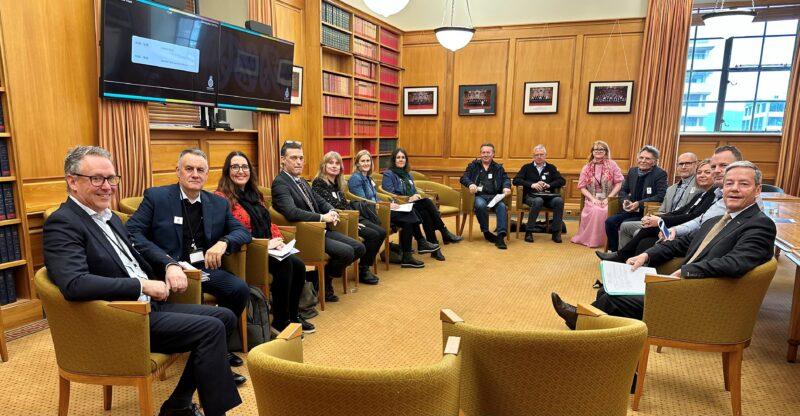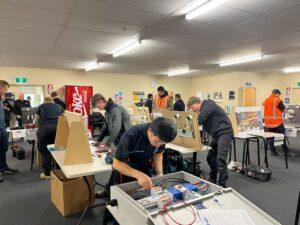The time has come
A few years ago, Winston Peters was talking of the country’s need for a Minister of Racing and I was talking of the country’s need for a Minister of Manufacturing. I wrote about it, received feedback and, guess what?, that ministry has still not happened and is still a no-brainer! Business leaders need to take action about this for the future of the country.
*Doug Green, publisher, NZ Manufacturer www.nzmanufacturer.co.nz
Andy Bayly, National Spokesperson for Manufaxcturing comments:
(In the picture)In July, representatives from the Hutt Valley Chamber of Commerce, local high schools and manufacturers met in Parliament with MP Andrew Bayly (seated, far right). Local MP Chris Bishop is also very supportive of the initiative.

-Andrew Bayly, National Spokesperson for Manufacturing and MP for Port Waikato
Over the last year, I have met with manufacturers from Whangarei in the north to Dunedin in the south. I have asked them what the Government could do to better support them.
National wants to not only support existing manufacturers, but to attract more people into the sector and more manufacturing to New Zealand. We need all parts of our economy firing on all cylinders if New Zealand is going to recover from the current economic crisis quickly.
To do so, we must reduce costs for our manufacturers, encourage investment, reduce taxes and make it easier for firms to hire and train new staff.
Why manufacturing matters
Manufacturing is critical to the New Zealand economy. It represents about 10 per cent of GDP and underpins over half of our exports.
The sector employs about 250,000 people, accounting for nearly 11 per cent of all jobs in the economy. Its contribution to R&D is also significant, accounting for 24 per cent of business spending on R&D ($649 million in 2020). This has been achieved against a backdrop of a government that has added costs and strangled businesses with red tape.
From the numerous roundtable discussions and workshops up and down the country, some key themes have been voiced by manufacturers where improvements can be made to drive the sector forward.
Making our manufacturers globally competitive
Improving the global competitiveness of New Zealand’s manufacturers means improving their productivity and accelerating the development of new products and services.
Encouraging and adopting Industry 4.0 is essential. We need to strengthen collaboration with research organisations in Australia and beyond, and ensure our own Callaghan Innovation remains focused on supporting the introduction of Industry 4.0 technologies on a broad front.
But to encourage manufacturers to make capital investments in new technologies, we need to ensure that skill development happens in tandem. One without the other won’t work. The lack of the requisite digital skills among their workforce, and in the wider labour market, prevents manufacturers from pursuing the introduction of digital technologies before capital investment decisions can even be considered.
Making manufacturing an attractive career choice
At many of the meetings around the country, manufacturers spoke about the difficulty of attracting people into the sector due to their preconceived perceptions of the industry. This is especially so amongst school leavers and people retraining after time away from the workforce or coming in from other industries, particularly women.
However, manufacturing is now predominantly a high-tech high-value sector, with businesses that utilise high levels of automated machinery, sometimes in a lights-out environment. Not a grease gun in sight!
How do we attract young people and how do we train them up to an adequate state where they can work proficiently in one of these high-tech manufacturing businesses?
One of the barriers identified is getting teachers on board who want to encourage young people to go into manufacturing, especially where the academic system leans more towards encouraging young people to go to university. A second obstacle is winning over parents so that they see manufacturing as a viable career path for their children.
Developing a pathway into manufacturing for school leavers
In the Hutt Valley, there are a large number of manufacturers who coincidentally are all located in close proximity, with the benefit of there also being secondary schools and a vocational education provider located nearby.
As a result of discussions at various meetings in the Hutt with manufacturers and the Hutt Valley Chamber of Commerce, we agreed that it would be useful to work on a programme that would firstly give students exposure to manufacturers, and then ultimately provide training so they will become work ready.
The programme will build on the Chamber’s Work Integrated Learning activity with engineering businesses in the Hutt Valley – work that is based on the successful Hastings Boys High School / Patton Engineering model.
Chamber CEO Patrick McKibbin says Work Integrated Learning is having a positive impact, helping school leavers transition to further education and employment, reducing risky behaviour and offending, and improving outcomes educationally and socially.
I invited a number of representatives of these organisations to Parliament to discuss this (see photo), as the first step to developing a programme for manufacturers that, ultimately, we hope to roll out across the country.
Recognising the value of manufacturing
Government cannot develop sound policies for a sector it doesn’t understand and of which it has no internal institutional knowledge. Therefore, as a prerequisite for the development of policies to better support the sector, we would give manufacturers a better voice within Government through the appointment of a Minister for Manufacturing and the creation of a dedicated resource (within MBIE) to support that Minister.
This would also serve as a signal to the wider public that the Government recognises the value of manufacturing to the NZ economy.



